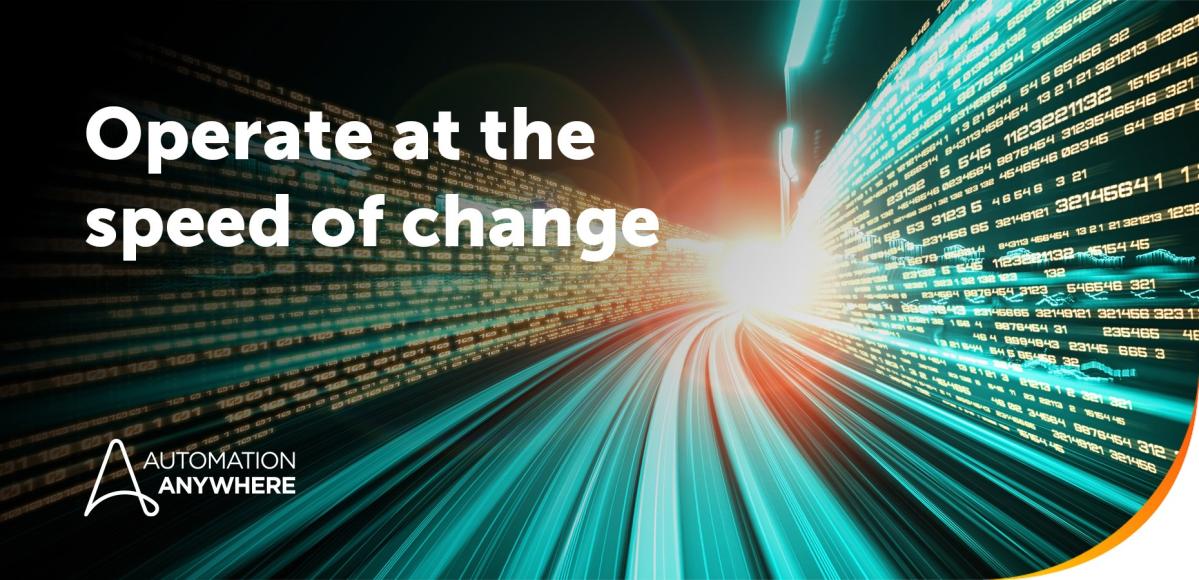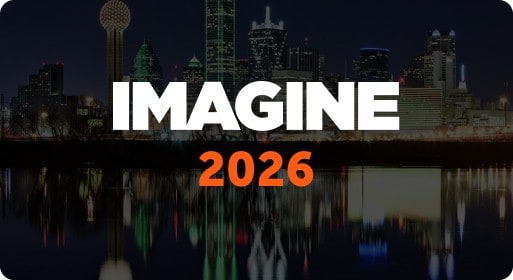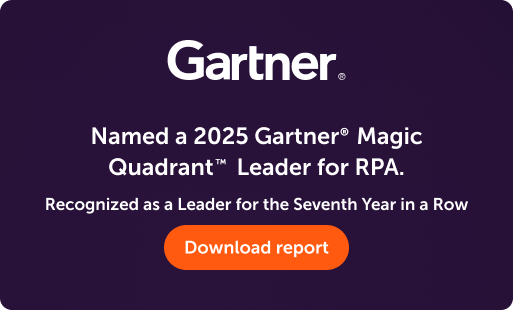- Login
- Search
- Contact Us
-
Have a question? Our team is here to help guide you on your automation journey.
-
Explore support plans designed to match your business requirements.
-
How can we help you?
-
- AI
AI Without the Hype From pilot to full deployment, our experts partner with you to ensure real, repeatable results. Get Started
- Automation Anywhere AI
-
- Solutions
Featured Agentic Solutions
Accounts Payable Invoice automation—No setup. No code. Just results. Accounts Payable
Customer Onboarding Scale KYC/AML workflows. Customer Onboarding
Customer Support Keep queues moving, even at peak load. Customer Support
Healthcare RCM Revenue cycle management that runs itself. Healthcare RCM
- Products
Platform Features
- Agentic process automation (APA)
- Robotic Process Automation (RPA)
- View all Products
-
- Resources
Get Community Edition: Start automating instantly with FREE access to full-featured automation with Cloud Community Edition.
Featured
 Named a 2025 Gartner® Magic Quadrant™ Leader for RPA.Recognized as a Leader for the Seventh Year in a Row Download report Download report
Named a 2025 Gartner® Magic Quadrant™ Leader for RPA.Recognized as a Leader for the Seventh Year in a Row Download report Download report- Become an Expert
- Developer Tools
- Get Support
- View all resources
-
- Partners
Find an Automation Anywhere Partner Explore our global network of trusted partners to support your Automation journey Find a Partner Find a Partner
- Find a Partner
- For Partners
-
Blog
Charting the Future of Enterprise Orchestration: The Agentic Advantage
Navigate to content
Can your automation adapt as fast as your business needs to? For most enterprises running legacy orchestration, the answer is no — and the gap is widening. And when your orchestration is behind, that means your competitors are moving faster and at lower cost, putting your business at risk.
Business conditions shift overnight while legacy orchestration systems require weeks of manual reconfiguration to respond. Market disruptions, regulatory changes, and supply chain volatility all demand immediate operational changes, but legacy platforms demand the opposite: specialized modeling, manual recoding, and staged deployment cycles — all before workflows can adjust to new business realities.
The mismatch isn't an implementation issue. It's architectural. Legacy orchestration was built assuming business processes would remain stable enough to hard-code, and exceptions rare enough to escalate to humans. Modern enterprises operate under the opposite conditions: continuous change is the baseline, and exceptions define the workflow. Systems designed for stability become bottlenecks when adaptation is what matters. That means enterprises relying solely on legacy orchestration risk being adrift as market conditions shift faster than their systems can adapt.
Agentic automation represents a fundamentally different approach: orchestration designed to operate at the speed of business change, not lagging months behind it.
The Agentic Advantage
Legacy Orchestration | Automation Anywhere Agentic Automation | Agentic advantage | |
|---|---|---|---|
Rules based (deterministic) | ✔ | ✔ | High-reliability process execution |
Agentic (non-deterministic) | ✖ | ✔ | Goal-driven autonomous execution |
Learns and adapts to change | ✖ | ✔ | Flexible, self-healing workflows |
Intelligent orchestration layers | ✖ | ✔ | Adaptive, dynamic coordination across agent types, RPA, APIs, documents, and human input. |
Unified platform | ✖ | ✔ | Consistent experience, observability, security, and control |
Low-code development | ✖ | ✔ | 3x faster time to automate |
Citizen developer support | ✖ | ✔ | Expanded automation coverage |
The legacy orchestration model: built for a different era
Legacy orchestration platforms were architected around the core assumption that business processes could be mapped, modeled, and managed. For structured, repeatable operations — such as case management, customer service routing, and approval chains — this approach delivered real value. At the same time, with the continuing evolution of enterprise technology, its constraints have grown into significant limitations.
Rigid, rules-based logic, is probably the easiest limitation to see. Every process step, every conditional branch; every exception handler must be defined. Business rules are hard coded into the system. When the business changes, it means manually updating the workflow.
Heavy reliance on human intervention is also a noticeable concern. Any scenario that falls outside the workflow requires human escalation. The system can't adapt, can't learn, and can't reason through new situations. It waits until someone tells it what to do.
Architectural limitations are less visible but are even more important. These platforms were built before cloud-native infrastructure, before AI became central to business operations, and before enterprises needed to orchestrate work across dozens of specialized tools and data sources. Retrofitting modern capabilities onto this foundation creates complexity, not agility.
Enterprises find they’ve spent months charting processes that become outdated within weeks. Development backlogs grow faster than teams can clear them. And as market conditions shift, the legacy orchestration systems that were supposed to create efficiency become a bottleneck.
What modern Agentic Process Automation means
Agentic Process Automation thinks differently about orchestration. Instead of orchestrating predefined tasks, modern platforms can orchestrate autonomous, goal-driven AI agents — systems that can perceive their environment, reason problems, plan actions, and adapt to achieve goals.
Here's what distinguishes truly agentic platforms:
- Autonomous agents, not rigid workflows. Rather than following a fixed script, AI agents operate with goal-directed autonomy. Give an agent a high-level objective — reconcile these invoices, resolve this customer issue, update inventory levels — and it determines the right path, handling variations and exceptions without human intervention.
- Dynamic adaptation, not manual reconfiguration. Agentic systems are built for unstructured data and changing conditions. An agent encountering an unexpected scenario doesn't break or escalate — it reasons through the problem, adjusts its strategy, and continues working toward the goal. The system learns from each interaction.
- Intelligent orchestration layers. Modern platforms are built to coordinate multiple specialized agents collaborating on complex workflows, sharing context and knowledge. The orchestration layer provides governance, ensures agents work toward aligned objectives, and manages the interplay between AI agents, RPA bots, APIs, and human workers.
- Enterprise ecosystem integration. Agentic platforms are designed to work across the modern enterprise stack — connecting AI models from multiple providers, pulling data from cloud and on-premise systems, invoking APIs across SaaS applications, and surfacing work to humans when judgment is needed.
The key point is that agentic automation is not just an improvement over legacy orchestration — it's an entirely different approach to enterprise automation.
But is it enterprise-ready?
Many vendors have recognized the shift toward agentic automation. The market is full of platforms claiming AI-powered intelligence and autonomous agents. But there's a significant gap between running proof-of-concept agents and orchestrating mission-critical business operations at enterprise scale.
True enterprise orchestration requires more than agentic capabilities. It requires:
- Governance and compliance that meets regulatory requirements across industries
- Observability that provides real-time visibility into what autonomous agents are doing and why
- Reliability that handles millions of executions without failures cascading across workflows
- Integration that works with existing enterprise applications, not just greenfield projects
- Speed that allows business teams to build and deploy automation without months of development cycles
This is the gap that Automation Anywhere's platform is built to bridge.
Where deterministic meets agentic: a governed platform for mission-critical automation
Automation Anywhere has architected an orchestration platform that integrates AI agents, RPA bots, APIs, and enterprise-grade governance, scalability, and observability into a single unified system.
Enterprises can now build, deploy, govern and orchestrate intelligent process agents — capable of reasoning, autonomous decision-making, and adaptation.
Accelerate development with low-code design
Legacy orchestration often requires specialized skills in BPMN modeling, complex process design tools, and costly dedicated teams of developers. This is a key limitation we hear about from customers who realize the urgent need to accelerate development.
Automation Anywhere provides process developers with a low-code, AI-assisted canvas where they can design end-to-end workflows that combine RPA bots, APIs, documents, AI agents, and human tasks. Import existing process documentation (including PDDs and BPMN files), use pre-built templates, or design from scratch. The platform's Process Reasoning Engine (PRE) — the industry's first of its kind — translates these designs into automation-ready flows.
The difference? Business analysts and process experts can build sophisticated automation without becoming software engineers. Development cycles shrink from months to weeks — or weeks to days — as development time accelerates by 3x compared to traditional approaches.
Intelligent orchestration through the Process Reasoning Engine
PRE uses insights from millions of real-world processes to power intelligent automation. It drives the reasoning behind agents like goal-based agents, document agents, and UI agents — which can autonomously navigate applications, interact with interfaces, and complete tasks across systems — the platform handles scenarios that would require manual intervention in traditional orchestration environments.
Business users interact with these agents through natural language, describing what they need accomplished rather than programming how to accomplish it. This democratizes automation, allowing domain experts to automate independently. For automation teams used to high-barrier-to-entry legacy orchestration tools, seeing someone design an automation without any training is a lightbulb moment.
Scalability that matches enterprise demand
Mission-critical workflows can't break when demand surges. Automation Anywhere's Elastic Runtime Engine is designed to scale horizontally, supporting millions of unique AI agent executions — 1.8 million in a single year, to be exact — and 46 million high-volume process automation workflows in the cloud simultaneously, per quarter.
The distributed architecture enables responsive resource allocation and failure recovery. Workflows self-heal when components fail. The system automatically adapts to demand spikes. Real-time observability dashboards provide visibility into performance across the entire automation estate.
This approach differs fundamentally from legacy orchestration platforms, which typically rely on centralized rules engines and require human intervention to manage exceptions. When load increases or failures occur, these architectures struggle to adapt dynamically, often creating operational bottlenecks that slow response times and limit scalability.
Seamless integration across the enterprise stack
Modern enterprises don't operate on a single platform. Work happens across dozens of applications, data sources, and AI tools. Automation Anywhere is built for this reality.
Process developers can connect to third-party AI agents and tools via MCP and A2A Protocol. The platform includes over 1,000 pre-built integrations with enterprise applications. Need something custom? The low-code Connector Builder allows teams to build integrations quickly without extensive development resources.
The result is orchestration that truly spans the enterprise, coordinating work across systems that were never designed to work together.
Enterprise-grade observability and security
Autonomous agents operating at scale require enterprise-grade governance. In fact, customers that have left legacy orchestration platforms cite the lack of a central governance layer as a major concern. Automation Anywhere provides real-time diagnostics, comprehensive audit trails, data masking, and regulatory-aware agents designed for compliance-sensitive industries.
Business leaders can monitor agent ROI, throughput, and health across distributed workflows through unified dashboards. When an agent makes a decision, the reasoning is traceable. When workflows run, every action is logged. When data moves between systems, security policies are enforced automatically.
For high-accountability processes across enterprise operations this kind of observability and security is non-negotiable. For Petrobras, it supports tax processing that delivers hundreds of millions in savings. Cargill was able to reduce its processing time to less than one minute per order, while KPMG found greater efficiency across multiple parts of its operations, from finance to recruiting to training and more.
This unified approach to observability and control is built into the platform's architecture. Legacy orchestration systems often require additional integrations, third-party monitoring tools, and manual oversight processes to achieve similar levels of governance — adding complexity and potential gaps in visibility.
Navigating into the future with agentic automation
While legacy platforms remain deeply anchored in business process management, they increasingly struggle to provide the agentic intelligence, horizontal scalability, and end-to-end observability that enterprise automation needs. And these gaps manifest as real business problems: projects take months to deploy while requirements change weekly. Workflows break when market conditions shift, demanding emergency fixes and manual workarounds. Teams spend more time maintaining automation than building new capabilities. A platform that was supposed to accelerate operations becomes the bottleneck.
These are the signals that legacy orchestration has reached its limits.
Agentic automation — built on a platform designed for autonomous intelligence, enterprise scale, and true ecosystem integration — makes possible what legacy orchestration could never achieve: autonomous operations that adapt as fast as markets change and enterprise-wide orchestration that turns volatility into competitive advantage. That’s why we are seeing customers moving from legacy orchestration platforms to our Agentic Process Automation. They’re able to automate and orchestrate more, reduce development and maintenance costs, and gain competitive advantage.
Make the shift to agentic automation now and chart your course into a future defined by doing things that weren't even on the horizon before.
To learn more about how agentic process automation enables AI agents to plan, reason, and collaborate, visit our Agentic Orchestration page.
About Peter White

Peter White is the Chief Product Officer at Automation Anywhere.
Subscribe via Email View All Posts LinkedInGet to know the Agentic Process Automation System.

For Students & Developers
Start automating instantly with FREE access to full-featured automation with Cloud Community Edition.



